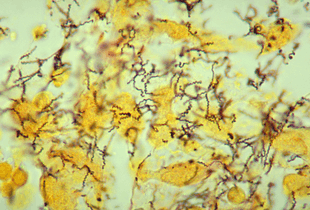Treponema
Treponema is a genus of spiral-shaped bacteria. The major treponeme species of human pathogens is Treponema pallidum, whose subspecies are responsible for diseases such as syphilis, bejel, and yaws. Treponema carateum is the cause of pinta.[2] Treponema paraluiscuniculi is associated with syphilis in rabbits.[3]
| Treponema | |
|---|---|
 | |
| Treponema pallidum spirochaetes | |
| Scientific classification | |
| Domain: | Bacteria |
| Phylum: | Spirochaetes |
| Order: | Spirochaetales |
| Family: | Spirochaetaceae |
| Genus: | Treponema Schaudinn 1905 emend. Abt, Göker & Klenk 2013 |
| Species[1] | |
| |
| Synonyms | |
| |
Phylogeny
The phylogeny is based on 16S rRNA-based LTP release 123 by 'The All-Species Living Tree' Project.[4]
| |||||||||||||||||||||||||||||||||||||||||||||||||||||||||||||||||||||||||||||||||||||||||||||||||||||||||||||||||||
| |||||||||||||||||||||||||||||||||||||||||||||||||||||||||||||||||||||||||||||||||||||||||||||||||||||||||||||||||||
Taxonomy
The currently accepted taxonomy is based on the List of Prokaryotic names with Standing in Nomenclature (LPSN)[5] and National Center for Biotechnology Information (NCBI).[6]
- ?Candidatus Treponema suis Molbak et al. 2006
- ?Treponema calligyrum ♠ Noguchi
- ?Treponema carateum ♥ (pinta-causing Treponema)
- ?Treponema minutum ♦ Dobell 1912
- ?Treponema pallidum ♦ (Schaudinn and Hoffmann 1905) Schaudinn 1905
- ?Treponema paraluisleporis ♠ Lumeij et al. 1994
- ?Treponema paraluiscuniculi ♦ (Jacobsthal 1920) Smibert 1974
- ?Treponema pertenue ♦ (Castellani 1905) Castellani & Chalmers 1910
- ?Treponema phagedenis ♠
- T. p. phagedenis ♠ (Noguchi 1912) Brumpt
- T. p. vaccae ♠ Evans et al. 2006
- ?Treponema refringens ♠ (Schaudinn and Hofmann 1905) Castellani and Chalmers
- ?Treponema vincentii ♠ Smibert 1984
- ?Treponema zioleckii ♠ Piknova et al. 2008
- Treponema amylovorum Wyss et al. 1997
- Treponema azotonutricium Graber et al. 2004
- Treponema berlinense Nordhoff et al. 2005
- Treponema brennaborense Schrank et al. 1999
- Treponema bryantii Stanton and Canale-Parola 1980
- Treponema caldarium (Pohlschroeder et al. 1995) Abt, Göker & Klenk 2013
- Treponema denticola (ex Flügge 1886) Chan et al. 1993
- Treponema isoptericolens Dröge et al. 2008
- Treponema lecithinolyticum Wyss et al. 1999
- Treponema maltophilum Wyss et al. 1996
- Treponema medium ♦ Umemoto et al. 1997
- T. m. bovis ♠ Evans et al. 2006
- T. m. medium ♠ Umemoto et al. 1997
- Treponema parvum Wyss et al. 2001
- Treponema pectinovorum Smibert and Burmeister 1983
- Treponema pedis Evans et al. 2009
- Treponema porcinum Nordhoff et al. 2005
- Treponema primitia Graber et al. 2004
- Treponema putidum Wyss et al. 2004
- Treponema saccharophilum Paster and Canale-Parola 1986
- Treponema socranskii Smibert et al. 1984
- T. s. paredis Smibert et al. 1984
- T. s. buccale Smibert et al. 1984
- T. s. socranskii Smibert et al. 1984
- Treponema stenostreptum (Zuelzer 1912) Abt, Göker & Klenk 2013
- Treponema succinifaciens Cwyk and Canale-Parola 1981
- Treponema zuelzerae (ex Veldkamp 1960) Canale-Parola 1980 emend. Abt, Göker & Klenk 2013
Notes:
♦ Type strain lost or not available
♠ Strains found at the National Center for Biotechnology Information (NCBI) but not listed in the List of Prokaryotic names with Standing in Nomenclature (LSPN)
♥ Strains not lodged at National Center for Biotechnology Information (NCBI) or listed in the List of Prokaryotic names with Standing in Nomenclature (LPSN)
The species Treponema hyodysenteriae and Treponema innocens have been reclassified into Serpulina hyodysenteriae and Serpulina innocens.[7]
References
- "Treponema" (HTML). NCBI taxonomy. Bethesda, MD: National Center for Biotechnology Information. Retrieved 27 February 2019.
- Antal GM, Lukehart SA, Meheus AZ (January 2002). "The endemic treponematoses". Microbes Infect. 4 (1): 83–94. doi:10.1016/S1286-4579(01)01513-1. PMID 11825779.
- Harper KN, Liu H, Ocampo PS, et al. (August 2008). "The sequence of the acidic repeat protein (arp) gene differentiates venereal from nonvenereal Treponema pallidum subspecies, and the gene has evolved under strong positive selection in the subspecies that causes syphilis". FEMS Immunol. Med. Microbiol. 53 (3): 322–32. doi:10.1111/j.1574-695X.2008.00427.x. PMID 18554302. Archived from the original on 2013-01-05.
- 'The All-Species Living Tree' Project."16S rRNA-based LTP release 123 (full tree)" (PDF). Silva Comprehensive Ribosomal RNA Database. Retrieved 2013-03-20.
- J.P. Euzéby. "Treponema". List of Prokaryotic names with Standing in Nomenclature (LPSN). Retrieved 2016-03-20.
- Sayers; et al. "Treponema". National Center for Biotechnology Information (NCBI) taxonomy database. Retrieved 2016-03-20.
- Stanton TB, Jensen NS, Casey TA, Tordoff LA, Dewhirst FE, Paster BJ (January 1991). "Reclassification of Treponema hyodysenteriae and Treponema innocens in a new genus, Serpula gen. nov., as Serpula hyodysenteriae comb. nov. and Serpula innocens comb. nov". Int. J. Syst. Bacteriol. 41 (1): 50–8. doi:10.1099/00207713-41-1-50. PMID 1704792.